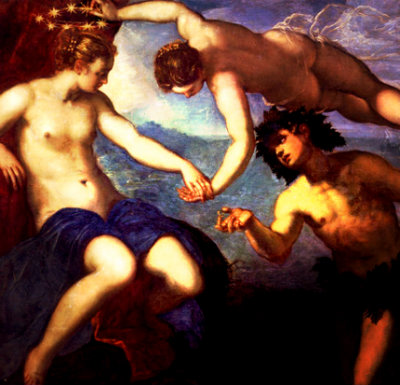100 Greatest Painters Artists Alphabetically Artists by Country Artists by Century Artists by Movement
Jacob Tintoretto
1519 - 1594
Italian High Renaissance Painter of the Venetian School
Stylistically influenced by the following painters - Michelangelo, Titian and Sano di Pietro
Education - Studied under Titian
Biography
Jacob Tintoretto was born during a flood in Venice, the year was 1519. Known as Tintoretto-the "little dyer"-because his father was a dyer by trade. He is described as a stormy and exalted spirit, a fiery passionate nature. Like all other Venetians of the day, Tintoretto had studied with Titian, and appears in his first works as a master of the Renaissance, tranquil in sentiment, gleaming and golden in color. He painted the radiant nudity of the youthful female form, studied the play and reflection of light as it softly caresses the back, and by means of a fairy-like landscape imparted to his paintings a solemn and majestic splendor. His representation of Christ Washing the Feet of His Apostles signifies, in its joyous Renaissance spirit, the zenith of his work as a worldly painter. The sunlight floods across the hall, and through the rows of shimmering palaces and the glittering mirror of lagoons.

"While in Titians portraits the most beautiful women of Venice pass by, among Tintoretto' s few woman occur, and such as do are harsh and mannish, massive and heavy. The portraits of dogs and procurators which he painted in an official capacity are the only ones which reveal him in his full greatness. Here also a harsh objectivity differentiates him form Titian. While the latter seeks beautiful poses and graceful movement, and by use of columns and a curtain imparts to the background also a festal and decorative effect, Tintoretto' s backgrounds are somber, enlivened with a coat of arms at most; and he is unable to render a beautiful pose because he never paints entire figures but mostly a three-quarter piece. Even the hands, upon which Titian bestowed so much attention, he subordinates to the head, either concealing them in Danish gloves or completing them in a few brushstrokes. By means of this simplification and also because he never paints transient traits, he achieves even more powerful and monumental effects than Titian. Velasquez learned much from Tintoretto' s portraits of senators.
In his portrait groups he appears as a predecessor of Frans Hals. He was the first to paint pictures intended for public buildings, which, like the Dutch doelenstukke, united a number of officials in a single group. But while the Dutch, in order to unite the figures, represented them at a banquet, Tintoretto' s nobility were far to proud to show themselves to the people in exalted condition. Without any bond of union, without any loss of composure, gloomy and reserved, they stand there, like Spanish grandness upon Italian soil.
But the real Tintoretto, the diligent master workman of the wild and fanatical style which dominated the following decades, can only be studied in his religious pictures. It seems as if suddenly a dark cloud had overcast the bright heaven of Venetian art. Instead of enchanting festal music of Veronese, funeral marches and trumpet blasts sound; instead of smiling woman, bloody martyrs and pale ascetics appear.
The Meaning of Sacred Symbols in Paintings. Most prominently featured symbols and their meaning:
☼☼☼☼☼
Important Words, People, Phrases, Characteristics related to the Italian Renaissance Art Movement - rebirth, rediscovery of the classical world, City-state, Humanism, Humanist, Francesco Petrarch, Reform, The Prince, Theocracy, The Inquisition, Human Reasoning, Medici Academy, publication of Della Pittura, a book about the laws of mathematical perspective for artists, sfumato, chiaroscuro, linear perspective, Heliocentric Theory, Petrarch, Baldassare Castiglione, The Book of the Courtier, liberal arts, civic humanism, Verrocchio, secularism, Leonardo Bruni, Lorenzo Valla, Neo-Platonism, nominalism, Giotto, Masaccio, Botticelli, Quattrocento, vanishing point, Savonarola, oligarchy spiritually significant, illuminated manuscript, idealized biblical themes, scriptorium, emotion, illuminator, iconoclast, Michelangelo and Leonardo Da Vinci, Age of Discovery, axonometric drawing, curiosity about the natural world, mythology, realistic use of colours and light, Bonfire of the Vanities, Old Testament stories, ethereal and foggy backgrounds, Gospel parables, The Blackdeath, romanticized landscapes, Christian symbolism. Paradise
Search for Artists by Century Important Painters Born in the 13th Century Important Painters Born in the 14th Century Important Painters Born in the 15th Century Important Painters Born in the 16th Century Important Painters Born in the 17th Century Important Painters Born in the 18th Century Important Painters Born in the 19th Century☼☼☼☼☼
If you feel you have worthwhile information you would like to contribute we would love to hear from you. We collect essential biographical information and artist quotes from folks all over the globe and appreciate your participation. When submitting please, if possible, site the source and provide English translation. Email to historyofpainter@gmail.com
© HistoryofPainters.com 2017
If you like this page and wish to share it, you are welcome to link to it, with our thanks.
Milanese School,
Ferrara School
Sienese School
Florentine School
Venetian School
Early Renaissance
High Renaissance
Northern Renaissance
Popular Questions About Renaissance Art History
What is the difference between Italian Renaissance art and Northern Renaissance art?
How did the Black Death impact European art history?
How did the Inquisition impact European art history?
What was the influence of the Medici Academy on Renaissance painters?
What was the Bonfire of the Vanities?
Who were the greatest painters of the Renaissance?